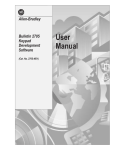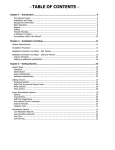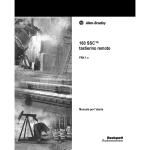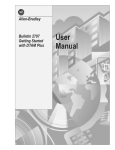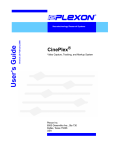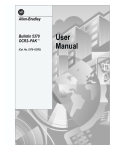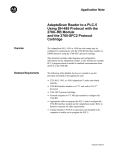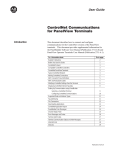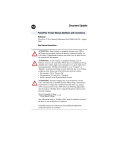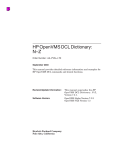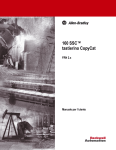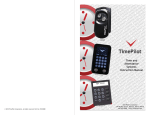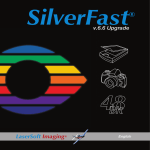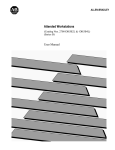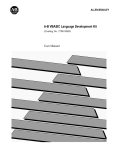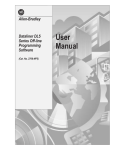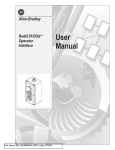Download 2708-802, Network Manager Software User Manual
Transcript
Allen-Bradley Network Manager Software (Cat. No. 2708–NNM) User Manual Important User Information Because of the variety of uses for the products described in this publication, those responsible for the application and use of this control equipment must satisfy themselves that all necessary steps have been taken to assure that each application and use meets all performance and safety requirements, including any applicable laws, regulations, codes and standards. The illustrations, charts, sample programs and layout examples shown in this guide are intended solely for purposes of example. Since there are many variables and requirements associated with any particular installation, Allen-Bradley does not assume responsibility or liability (to include intellectual property liability) for actual use based upon the examples shown in this publication. Allen-Bradley publication SGI-1.1, Safety Guidelines for the Application, Installation, and Maintenance of Solid-State Control (available from your local Allen-Bradley office), describes some important differences between solid-state equipment and electromechanical devices that should be taken into consideration when applying products such as those described in this publication. Reproduction of the contents of this copyrighted publication, in whole or in part, without written permission of Allen-Bradley Company, Inc., is prohibited. Throughout this manual we use notes to make you aware of safety considerations: ! ATTENTION: Identifies information about practices or circumstances that can lead to personal injury or death, property damage or economic loss. Attention statements help you to: • identify a hazard • avoid the hazard • recognize the consequences Important: Identifies information that is critical for successful application and understanding of the product. Table of Contents Bulletin 2708 Network Manager Software A–B Introduction Chapter 1 What is NM? . . . . . . . . . . . . . . . . . . . . . . . . . . . . . . . . . . . . . . . . . . . . . Installation . . . . . . . . . . . . . . . . . . . . . . . . . . . . . . . . . . . . . . . . . . . . . . . Connections and Parameters Chapter 2 The Menus Chapter 3 Physical Connections . . . . . . . . . . . . . . . . . . . . . . . . . . . . . . . . . . . . . . . Workstation Master – COM1 Parameters . . . . . . . . . . . . . . . . . . . . . . . Starting NM . . . . . . . . . . . . . . . . . . . . . . . . . . . . . . . . . . . . . . . . . . . . . . Host PC Communication Parameters . . . . . . . . . . . . . . . . . . . . . . . . . . Verifying Correct Operation . . . . . . . . . . . . . . . . . . . . . . . . . . . . . . . . . The Main Menus . . . . . . . . . . . . . . . . . . . . . . . . . . . . . . . . . . . . . . . . . . F1 – Help . . . . . . . . . . . . . . . . . . . . . . . . . . . . . . . . . . . . . . . . . . . . . F2 – Network Status . . . . . . . . . . . . . . . . . . . . . . . . . . . . . . . . . . . . . F3 – Global Time Set . . . . . . . . . . . . . . . . . . . . . . . . . . . . . . . . . . . . F4 – Program Download . . . . . . . . . . . . . . . . . . . . . . . . . . . . . . . . . F5 – Reset The Network . . . . . . . . . . . . . . . . . . . . . . . . . . . . . . . . . . F6 – Command To Be Sent . . . . . . . . . . . . . . . . . . . . . . . . . . . . . . . F7 – Supervisor Menu . . . . . . . . . . . . . . . . . . . . . . . . . . . . . . . . . . . Help . . . . . . . . . . . . . . . . . . . . . . . . . . . . . . . . . . . . . . . . . . . . . Change Configurations . . . . . . . . . . . . . . . . . . . . . . . . . . . . . . . Initiate Comm . . . . . . . . . . . . . . . . . . . . . . . . . . . . . . . . . . . . . . Terminate Comm . . . . . . . . . . . . . . . . . . . . . . . . . . . . . . . . . . . Direct Interaction . . . . . . . . . . . . . . . . . . . . . . . . . . . . . . . . . . . Begin a Loaded Program . . . . . . . . . . . . . . . . . . . . . . . . . . . . . Abort a Programs . . . . . . . . . . . . . . . . . . . . . . . . . . . . . . . . . . . Change Configuration / Network Layouts . . . . . . . . . . . . . . . . Change Configuration / Config. Parameters . . . . . . . . . . . . . . Change Configuration / Options . . . . . . . . . . . . . . . . . . . . . . . . Change Configuration / File / Data Captured . . . . . . . . . . . . . . Change Configuration / File/Data Capture / Directory / File Names . . . . . . . . . . . . . . . . . . . . . . . . . . . Change Configuration / File/Data Capture / Capture Field Editing . . . . . . . . . . . . . . . . . . . . . . . . . . . . 1–1 1–1 2–1 2–1 2–2 2–2 2–3 3–1 3–3 3–3 3–3 3–4 3–4 3–4 3–5 3–5 3–5 3–6 3–6 3–6 3–7 3–7 3–7 3–8 3–9 3–11 3–12 3–12 i Table of Contents Bulletin 2708 Network Manager Software Overview of Capture Field Editing . . . . . . . . . . . . . . . . . . . . . . . . . Change Configuration / Menu Editing . . . . . . . . . . . . . . . . . . . Change Configuration / Site List Editing . . . . . . . . . . . . . . . . . Change Configuration / Modem Parameters . . . . . . . . . . . . . . Parameters . . . . . . . . . . . . . . . . . . . . . . . . . . . . . . . . . . . . . . . . . . . . Change Configuration / Save Changes . . . . . . . . . . . . . . . . . . . F8 – File Services Menu . . . . . . . . . . . . . . . . . . . . . . . . . . . . . . . . . . File Services / Program Download . . . . . . . . . . . . . . . . . . . . . . File Services / File / Chain Download . . . . . . . . . . . . . . . . . . . File Services / Directory Listing . . . . . . . . . . . . . . . . . . . . . . . . File Services / Read / Display File . . . . . . . . . . . . . . . . . . . . . . File Services / Edit a Text File . . . . . . . . . . . . . . . . . . . . . . . . . File Services / Compile a BASIC File . . . . . . . . . . . . . . . . . . . File Services / Kill Files in a DH5 . . . . . . . . . . . . . . . . . . . . . . File Services / Exit to DOS Shell . . . . . . . . . . . . . . . . . . . . . . . The Basics Chapter 4 Getting NM to Recognize the Network . . . . . . . . . . . . . . . . . . . . . . . . . Resetting The Network . . . . . . . . . . . . . . . . . . . . . . . . . . . . . . . . . . . Determining Network Status . . . . . . . . . . . . . . . . . . . . . . . . . . . . . . Setting The Time On The Workstations . . . . . . . . . . . . . . . . . . . . . . Downloading A Program To The Workstations . . . . . . . . . . . . . . . . Command Line Options . . . . . . . . . . . . . . . . . . . . . . . . . . . . . . . . . . Starting Up NM . . . . . . . . . . . . . . . . . . . . . . . . . . . . . . . . . . . . . . . . In The Event Of A Power Failure . . . . . . . . . . . . . . . . . . . . . . . . . . Determining Where The Data Goes . . . . . . . . . . . . . . . . . . . . . . . . . Another Way To Collect The Data . . . . . . . . . . . . . . . . . . . . . . . . . . ii 3–14 3–14 3–15 3–15 3–15 3–15 3–16 3–16 3–17 3–17 3–17 3–17 3–18 3–18 3–18 4–1 4–2 4–2 4–2 4–2 4–3 4–4 4–4 4–4 4–5 Table of Contents Bulletin 2708 Network Manager Software Advanced Topic Chapter 5 Customizing NM . . . . . . . . . . . . . . . . . . . . . . . . . . . . . . . . . . . . . . . . . . Files In Workstations . . . . . . . . . . . . . . . . . . . . . . . . . . . . . . . . . . . . File Downloading . . . . . . . . . . . . . . . . . . . . . . . . . . . . . . . . . . . . . . . File Services / File / chain download . . . . . . . . . . . . . . . . . . . . File Directory Of Workstations . . . . . . . . . . . . . . . . . . . . . . . . . . . . File Services / Directory listing . . . . . . . . . . . . . . . . . . . . . . . . Deleting Files On A Workstation . . . . . . . . . . . . . . . . . . . . . . . . . . . File Services / Kill files in DH5 . . . . . . . . . . . . . . . . . . . . . . . . Downloading Chained Executables . . . . . . . . . . . . . . . . . . . . . . . . . File Services / File/chain download . . . . . . . . . . . . . . . . . . . . . Editing A-B VBASIC Programs . . . . . . . . . . . . . . . . . . . . . . . . . . . Supervisor Menu / Change Configuration / File Data Capture / Directory and File Names . . . . . . . . . . . . . . . . . . . . . . . . . File Services / Edit a text file . . . . . . . . . . . . . . . . . . . . . . . . . . Compiling A-B VBASIC Programs . . . . . . . . . . . . . . . . . . . . . . . . . File Services / Compile a BASIC file . . . . . . . . . . . . . . . . . . . . Main Menu or File Services . . . . . . . . . . . . . . . . . . . . . . . . . . . 5–1 5–3 5–3 5–3 5–4 5–4 5–4 5–4 5–5 5–5 5–6 5–6 5–6 5–6 5–6 5–6 iii Chapter A–B 1 Introduction What is NM? NM is an acronym for Network Manager Software (Catalog No. 2708–NNM). The program runs on a PC compatible computer, and provides network management and data collection for a network of workstations. The latest version, NM V5.0, provides instant help, menu driven configuration files, file lookup services, a transport layer protocol, and program development aids. NM is highly configurable, allowing it to be used in a wide variety of applications. By restricting access to configuration and direct interaction functions, NM can be configured as an end–user data collector. By adding access to data processing programs, NM can be used as a command shell for systems integrators using workstation networks. Installation Before installing NM onto the hard disk, make a working copy of the release diskette by using either the DOS DISKCOPY or COPY commands. Store the original in a safe location. To install NM onto your hard disk, place the working copy in either the A: or B: floppy drive. If you are using the A drive, type the following commands. Change to B: if using B drive. A: INSTALL C In this example, C is the hard drive where you want NM installed. You may use D, E, or any other valid drive name. NM will now be installed in a directory named \ NM in the root directory of the hard drive you specified. 1–1 Chapter 1 Introduction Installation (cont’d) If you want to take full advantage of the programming aids, NM must have access to both LXB.EXE (the A-B VBASIC compiler) and the Visual BASIC (VB) library directory. In order to find LXB, it should either be copied to the NM directory or you should add SET LXB = C: \ LIB \ or another valid pathname in your AUTOEXEC.BAT so that NM can find it. Also you may have to add: LIB = C: \ VB \ or the correct path to the QB45 library directory. You can make NM available from any directory by adding: NM = C: \ NM \ or the correct path to the NM directory in your AUTOEXEC.BAT. What Part of this Manual Should I Read? The section on CONNECTIONS & PARAMETERS should be all that is necessary to read for the individual doing the installation and testing of the network. The sections on THE MENUS, THE BASICS & RETRIEVING DATA should be all that is necessary to read for the individual whose responsibility it is to collect the data from the workstations. The Systems Integration individual should be familiar with the entire Network Manager Manual. Which Keys should I Know About? All of the functions are started by pressing a function key or the highlighted letter corresponding to that function key. References to keys in this manual will look like the following: Press < F4 > / ’P’ to .... where < F4 > represents the forth function key and ‘P’ represents the highlighted letter of that function. To back out of a menu, press the ESCAPE key. References to the ESCAPE key in this manual will look like this: Press < ESC > to .... where < ESC > represents the ESCAPE key. Usually < F1 > / ‘H’ will give a screen of help in the current area of interest. To get rid of the help text, press < ESC >. 1–2 Chapter A–B 2 Connections and Parameters Physical Connections You only need to read this section if you have not connected the host PC to the master workstation. The master workstation’s COMl or COM2 port must be connected to an unused COM port of the host PC. For most PCs, this is an RS–232 port and requires a workstation with an RS–232 COM1 port (Catalog No. 2708–DH5B2L). If the host communications is accomplished using a host with an RS–422 COM port, then make sure that the workstation was ordered with an RS–422 port on COM1 (Catalog No. 2708–DH5B4L). The COM2 port (or AUX port) on the workstation cannot be used for host/workstation communications, but the COM2 or AUX port on the PC can. The cable required from the workstation to the host PC will be a null modem cable. A wiring diagram for a null modem cable can be found in the Attended Workstation User Manual (Catalog No. 2708–ND001). We recommend that the cable be made from this diagram. Note: Be sure to select the correct diagram (RS–232 or RS–422). Workstation Master – COM1 Parameters The workstation that will be used for host communications must be configured to be a “MASTER” or a “GATEWAY” type workstation. The following discussion is for those who have not already configured their workstation as a master for interaction with NM. The following paragraphs assume some knowledge of the configuration menus on a workstation. For more information on the configuration menus, refer to the Attended Workstation User Manual (Catalog No. 2708–800). Note: The Master workstation will not communicate with the host if the Master workstation has been left in the configuration menus. You MUST press the EXIT key several times to exit menus after you have configured the proper parameters. The recommended workstation configuration is illustrated below. Mandatory settings are in BOLD: Network Menu (Main Menu) Comm Port Menu Terminal Number Terminal Type Lower Poll Addr Upper Poll Addr Comm Port Mode Comm Baud Rate Comm Data Bits Comm Parity Comm Stop Bits Comm CRLF Comm Echo 1 Master 1 99 Polled 9600 7 Even 1 Disabled Disabled 2–1 Chapter 2 Connections and Parameters Starting NM NM is executed by typing ‘NM’ at the DOS prompt. If the file NM. EXE is not in the current directory, it must be in a directory included in the last DOS PATH command. NM will immediately attempt to communicate with the master workstation. This is acceptable if the host communication parameters are set correctly, but if they are not then press <ESC> to bypass the initial communications. Host PC Communication Parameters The following discussion is for those who have not setup NM’s communications parameters. 1. 2. 3. 4. 5. Start NM Bypass NM’s initial attempt at communicating by pressing <ESC>. Press <F7>/‘S’ to get to the Supervisor Menu. Press <F2>/‘C’ to get to the Change Configuration Menu. Press <F3>/‘C’ to get to the Configuration Parameters. At this point, select the COM port to which the cable from the Master workstation is connected. If it differs from the default, then simply type in a ‘1’ or a ‘2’ and press <ENTER>. Next, type in the baud rate which the Master workstation was set to and press <ENTER>. Next, press <ESC> to back out of the Configuration Parameters and press <F4>/‘O’ to get to the Options Menu. Make sure that ‘Use Request/Response Mode Instead of Polled Mode’ is set to ‘No’. Press <ESC> to back out of the Option Menu to the Change Configuration Menu. Press <F2>/‘N’ for Network Layout. Using the up and down arrow keys on the PC’s keyboard, highlight the Master terminal and press <ENTER>. The Edit Station menu should appear. The terminal number of the Master workstation needs to be entered. For the Master workstation, the workstation number will be the same. Press <F10> when finished. Stations can be edited by highlighting them then pressing <ENTER>. To add a station to the list of stations, simply press the <DOWN ARROW> key until no more stations are highlighted and press <ENTER>. Then edit the Edit Station menu and press <F10>. Once the Network Layout is complete, press <ESC> and answer ‘Y’ to save changes to network layout. Then press <F9>/‘S’ to save changes done to any other menus. Press <ESC> twice to return to the Main Menu. 2–2 Chapter 2 Connections and Parameters Verifying Correct Operation From the Main Menu press <F5>/‘R’ to Reset the Network. Then press <F2>/‘N’ to see the Network Status. The column Status should show workstations coming on–line or already on–line. If this is not the case, verify that all the steps in the chapter have been done correctly. 2–3 Chapter A–B 3 The Menus The Main Menus Once NM. EXE is executed, NM will try to communicate with the Master workstation. If it is unsuccessful, the bottom of the screen will show the retry count. The <ESC> key can be pressed to bypass the initial communications thus allowing the Main Menu to be displayed. The Main Menu should appear on the left half of the screen. It consists of the most commonly used functions and allows access to the other menus. The Main Menu should look something like the following. DH5 Network Manager V5.0 Main Menu F1 F2 F3 F4 F5 F6 F7 F8 F9 F10 : : : : : : : : : : Help Network status Global time set Program download Reset the network Command to be sent Supervisor Menu File services Exit Program Mar 04, 1991 07:40:30 am Network Status Current Site : NM Stations Online : Stations Offline : 1 0 Records Input : Records Output : 0 0 Network Com Active If the NM Main Menu appears different than above, it may be because the version of NM that you are using has been customized for your application. If this is the case, contact the systems integrator that did the installation for documentation specific to your application. The function keys specified or the highlighted letters will initiate the command or menu desired. 3–1 Chapter 3 The Menus The Main Menus (cont’d) This is the menu hierarchy: 1. Main Menu F1 Help F2 Network Status F3 Global Time Set F4 Program Download F5 Reset the Network F6 Command to be Sent F7 Supervisor Menu F1 Help F2 Change Configuration F2 Network Layout F3 Config Parameters F4 Options (Yes/No) F5 File/Data Capture F2 Directory/File Names F3 Capture/Field Editing F6 Menu Editing F7 Site List Editing F8 Modem Parameters F9 Save Changes F3 Initiate Comm F4 Terminate Comm F5 Direct Interaction F6 Begin a Loaded Program F7 Abort a Program F8 Change Configuration F8 File Services F1 Help F2 Program Download F3 File/Chain Download F4 Directory Listing F5 Read/Display File F6 Edit a Text File F7 Compile a BASIC File F8 Kill Files in a Workstation F9 Exit to DOS Shell F10 Exit Program 3–2 Chapter 3 The Menus The Main Menus (cont’d) F1 – Help Pressing <F1> or <H> from the Main Menu will replace the screen with the Help screen. The first page of Help briefly describes NM. The second page describes the layout of the Main Menu and Network Activity Statistics screen (the screen that you see when NM is first started). The third page is general information about using NM. Pressing <F1> again will cause the Help Index to be displayed. Using the arrow keys various subjects can be highlighted. Once highlighted, pressing <ENTER> will cause information about specific topics to be displayed. To exit the Help Menu press <ESC> to get back to the current menu. F2 – Network Status The Network Status Menu is accessed by hitting <F2>/‘N’ from the Main Menu. The status information displays various items of interest on each of the terminals configured in the Layout Menu of the Change Configuration Menu of the Supervisor Services. Information such as workstation number, workstation type, online/offline status, records transmitted, records received, serial number, firmware type, memory configuration, contents of the display and what types of input records have been received is available. It is not possible to display all this information on the screen at one time, so seven different formats of status are possible. By pressing the keys <0> through <6> the different formats are displayed. F3 – Global Time Set The Global Time Set command takes the host PC’s time and uses it to set the time on the workstations. This command should be done weekly to keep the time on the workstations consistent with the host PC. For automated time synchronization between NM and the network ‘Set the time on all units during startup’ can be set to ‘Yes’ in the Supervisor Menu / Change Configuration / Options (Yes/No) menu. 3–3 Chapter 3 The Menus The Main Menus (cont’d) F4 – Program Download The workstations do not have a program loaded when shipped from the factory. Without a program loaded, the workstations will not be very useful. The Program Download command will prompt the user for the name of the program to download. If no path is given, NM will expect to find the program in the ‘Program File Directory’ which is specified in the Supervisor Menu / Change Configuration / File/Data Capture / Directory/File Names menu. Next the user will be prompted to enter the number of the workstation to download. If no workstation number is specified, the program will be downloaded to all of the workstations on the network. When a new program is being downloaded, the workstation immediately stops running the current program. Even downloading the same program that is currently running will stop the current program. So, downloading a program to all of the workstations on the network may not be desirable if there is a possibility that one or more of the workstations may be in the middle of some sort of application data collection. F5 – Reset The Network This command is used to bring workstations online that have gone offline or never come online. Consult with the Status Menu to find out the online/offline status of the workstations in the network. The Reset Network command also causes the Master workstation to adjust its upper and lower polling addresses to include only those workstations which it finds present at that time. F6 – Command To Be Sent This is a useful utility for sending commands to specific workstations. It was designed as a tool for simple queries during the installation of a network. Consult the Attended Workstation User Manual (Catalog No. 2708–ND001) for the format of the ‘Network Directives’. 3–4 Chapter 3 The Menus The Main Menus (cont’d) F7 – Supervisor Menu The Supervisor Menu is used to configure NM for a specific site and is used for occasional maintenance. The Supervisor Menu will look something like this: DH5 Network Manager V5.0 Supervisor Menu F1 : F2 : F3 : F4 : F5 : F6 : F7 : F8 : F9 : F10: Help Change Configuration Initiate Comm Terminate Comm Direct Interaction Begin a loaded program Abort a program Exit Service Mar 04, 1991 07:41:28 am Network Status Current Site : NM Stations Online : Stations Offline : 1 0 Records Input : Records Output : 0 0 Network Com Active Help The Help that is available from the Supervisor Menu is the same Indexed Help that is available from the Main Menu. Refer to the previous discussion of Help from the Main Menu. Change Configurations Note: You MUST choose the Save Changes (F9/‘S’) option before exiting the Change Configuration menu or you will lose whatever changes you make here. The Change Configuration Menu is used to configure a specific site. The Network Layout, communication parameters, special NM options and Menu Editing are all sub–functions of the Change Configuration menu. The Change Configuration menu should appear as follows when initiated. A discussion of the topics under the Change Configuration menu follows this section on the Supervisor Menu. 3–5 Chapter 3 The Menus The Main Menus (cont’d) DH5 Network Manager V5.0 Change Configuration F1 F2 F3 F4 F5 F6 F7 F8 F9 F10 : : : : : : : : : : Help Network layout Config parameters Options (Yes/No) File/Data capture Menu editing Site list editing Modem parameters Save Changes Exit Service Mar 84, 1991 07:41:59 am Network Status Current Site : NM Stations Online : Stations Offline : 1 0 Records Input : Records Output : 0 0 Network Com Active Initiate Comm This option starts NM communicating with the master workstation. This is approximately the same as a reset network command but the upper and lower polling addresses are not set on the Master workstation. This command can also be performed from any menu by pressing <ALT><I>. Terminate Comm This command terminates communications with the workstations and puts NM in a network communications inactive mode. It is good practice to terminate communications prior to changing any of the configuration parameters that may affect host communications. This command can also be performed from any menu by pressing <ALT><T>. Direct Interaction The Direct Interaction command allows the user to interact with the network just as you would with a standard communications package. This is a useful feature for installers and systems integrators since it allows you to see all the data from the Master workstation. You will need to have a good working knowledge of network directives and their responses before beginning. Refer to Attended Workstation User Manual (Catalog No. 2708–ND001) for more information. 3–6 Chapter 3 The Menus The Main Menus (cont’d) Begin a Loaded Program Programs that are loaded into a workstation that have terminated or been terminated can be restarted with this command. If you choose to start a program that resides in the workstation’s file memory, as opposed to the program currently in the program memory (the default program) you must enter the programs name and press <ENTER>. To start the program that is in the workstation’s program memory, simply press <ENTER> to this query. The second query allows you to specify a particular workstation or all the workstations. Abort a Program A program that is running in a workstation can be terminated by this command. Change Configuration / Network Layouts The Network Layout is used to define the role of each workstation in the network. This is information that must be supplied for NM to work properly. NM matches this information with information it retrieves from all the units to determine their online status. Workstations can be added to the list by pressing the <DOWN ARROW> key until no station numbers are highlighted. At this time you can press the <ENTER> key to add a station. After pressing <ENTER> the screen should be similar to the following: Edit Station ( 2 ) Terminal Number of master/sub–master :1 Terminal Number of this station :2 Terminal type of this station : Normal station (backbone) Terminal location in building : Cabling description/location info : Terminal uses A-B VBASIC programs : Yes Terminal temporarily out of service : No Note: In this menu, “Terminal” = workstation. 3–7 Chapter 3 The Menus The Main Menus (cont’d) Use F10 when you are finished editing the form. The ‘Terminal number of the master/sub–master’ and the ‘Terminal number of this station’ are used by NM to address this station. All the units on the backbone (the master, the concentrators, the sub–masters, and the normal terminals which are connected to the master directly) will reflect the number of the Master workstation in the top query. Each workstation in the network will have a different address (master/submaster number terminal number). The workstation number can be determined by entering the workstation’s configuration menu. For more information on the Configuration Menus refer to the Attended Workstation User Manual (Catalog No. 2708–ND001). The terminal (workstation) type is selected using the space bar. The ‘Terminal temporarily out of service’ field is used by NM when it is matching the list of known workstations with the list of workstations that have come online, so that it does not wait for workstations to come online that are temporarily out of service. When displaying the Network layout screen it is also possible to edit a stations data or remove the station entirely from NM’s list of stations. Stations are edited by highlighting their station number and pressing the <ENTER> key. The Edit Station screen will appear and you are free to move the cursor from field to field as necessary to update the information about a particular unit. Stations are removed from the list of stations by using the arrow keys to highlight the station to be deleted and pressing the <DEL> key. Change Configuration / Config. Parameters Note: You MUST choose the Save Changes (F9/‘S’) option before exiting the Change Configuration menu or you will lose whatever changes you make here. The Configuration Parameters are information that NM uses in communicating with the network. It specifies the serial port that the host computer has connected to the Master workstation and it specifies the baud rate at which the host computer is to use when communicating with the Master workstation. 3–8 Chapter 3 The Menus The Main Menus (cont’d) The Supervisor Menu contains information about the network that is critical or may not be easily replaced. If this is the case, then adding a password to the Supervisor Menu may be desired. Just make sure that you have the password written down somewhere if you do not use the Supervisor Menu often. ‘The Name of this Program’ field is used by NM when it displays its name at the top of the screen. This is to allow VARs and system integrators to make NM look like part of their own product. Simply edit the field to give NM a custom look. ‘Name of the Network Site’ is used when NM is used with a modem to call up multiple sites. If you are using NM in ‘Remote Multiple Site Mode’ this field would be used to delineate between remote locations. The ‘Maximum Number of Sites’ field specifies the maximum number of remote sites that NM will be responsible for dialing. The ‘Maximum Number of Stations per Site’ refers to the maximum number of workstations that will be present for any given site. The ‘Maximum Terminal Number in system’ field is used to determine the maximum workstation number that will be used at any given site. The ‘Online/Reset Wait’ field specifies the maximum amount of time that NM will wait for units to come online before giving up on them. The ‘Batch Incoming Data Wait’ field specifies the maximum amount of time that NM will wait in seconds for any multiple data records received from one station. The ‘Timeout Between Polls’ field tells NM how long to wait between attempts at getting a response to a poll for data. The ‘Number of Poll Retries to Master’ field tells NM the number of times to try to bring the master online before giving up. Change Configuration / Options These option allow further customization of NM. The user enables and disables options by toggling between Yes and No with the <SPACE BAR>. The menu should look similar to the following: 3–9 Chapter 3 The Menus The Main Menus (cont’d) DH5 Network Manager V5.0 Mar 04, 1991 07:49:22 am Configuration Options : (Yes/No) Parameters Don’t wait for all units to come on line in startup Start interactive mode after startup is completed Use Request/Response Mode instead of Pulled Mode Pause if all units don’t come on line in starup Perform an immediate network rest in startup Display all input from network on status line Assume that this may be an alternate master Don’t display program lines during download Set the time on all units during startup Exit after data collection is completed Display system statistics in heading Remote sites (modem accessed) : Yes : Yes : No : No : Yes : No : No : No : No : No : No : No Use F10 when you are finshed editing the form NM can be configured so that it does not wait for all the workstations to come online. This means that the operator would have to manually check the Network Status menu specifically to determine if all the workstations are operating correctly. By default, NM waits for all the workstations in the configuration to come online before displaying the Main Menu. NM defaults to interactive mode at startup. This means that after NM has initiated communications the user is allowed to interact with NM, in other words you can use all features of NM. NM can be configured to use a special protocol called Request/Response. In Request/Response mode, data sent and received from NM to the master is verified by means of a checksum. Note: The Master workstation’s ‘Comm Mode’ parameter in the ‘Comm Menu’ of the configuration menus must be set to Request/Response also, for this to work. NM will pause, by default, if all the units don’t come online within the specified amount of time. This can be overridden. NM can be configured to perform a network reset in its startup sequence. This often provides a quicker method of bringing all the workstation online. Displaying all inputs from the network on the status line can be enabled from this menu. The ‘Assume that this may be an Alternate Master’ field alerts NM that this may be an alternate master and not the main master of the network. 3–10 Chapter 3 The Menus The Main Menus (cont’d) One of the fields disables the echo of the program download. Another option causes the time to be set in all the workstations every time NM is executed. NM can be setup to terminate execution after all the data has collected from the network. Some networks may have interconnections in the form of modems. For such systems, NM can activate modems and dial out to retrieve data over the phone lines. This mode is disabled by default. Change Configuration / File / Data Captured The File/Data Capture menu allows you to configure where the various file(s) are to reside on the hard disk and allows you to specify where specific records are to be put. The menus should look similar to the following: DH5 Network Manager V5.0 Files/Data Capture F1 F2 F3 F4 F5 F6 F7 F8 F9 F10 : : : : : : : : : : Help Directory/File names Capture field editing Exit Service Mar 04, 1991 07:50:00 am Network Status Current Site : NM Stations Online : Stations Offline : 1 0 Records Input : Records Output : 0 0 Network Com Active 3–11 Chapter 3 The Menus The Main Menus (cont’d) Change Configuration / File/Data Capture / Directory / File Names This menu tells NM the names of the default programs to download, the name of the editor being used, and the various file directories if other than the current directory. DH5 Network Manager V5.0 Mar 06, 1991 01:30:57 pm Directories and File Names Default A-B VBASIC file to download : DEFAULT.LXE Name of text file editor : Data file Program file Help file Network site/site list A-B VBASIC compiler Directory Directory Directory Directory Directory : : : : : Use F10 when you are finished editing the form Change Configuration / File/Data Capture / Capture Field Editing DH5 Network Manager V5.0 Mar 06, 1991 01:32:15 am Edit Date Field : Field 1 (1) Short name of field to display : Field 1 Position of key text (text to match) in record : 6 Key to match at the above position : File to store matching records into : Date/time stamp each record ? Yes Decode record headings to mm–mm: form ? Yes Use Network/multi–tasking file access ? No Use F10 when you are finished editing the form Workstations in a network may send different types of data. And it may be desirable to store certain records in certain files. 3–12 Chapter 3 The Menus The Main Menus (cont’d) Programmers may wish to precede their data with a character that specifies the type of data. This character would be used by NM to determine which file to put this data in. An example would be a network in which two applications were occurring. Half the workstations do time and attendance and the other half are used for inventory control. All the data from both applications comes into the Master workstation and is sent to the host which is running NM. If the time and attendance data is preceded by an I or an O, for in and out respectively, the ‘clock ins’ could be stored in one file and the ‘clock outs’ in another. The rest of the data could go in the inventory file. Examples: 0104000101IEmployee Name, TimeIn, Date 0106000201OEmployee Name, TimeOut, Date 0108000401 Any other type of record............ Let’s set up a file to capture the records with the first examples format. Get to the Main Menu by pressing <ESC> a few times. Now select the following menus to get to ‘Capture field editing’ menu, Supervisor Menu / Change Configuration / File/Data Capture / Capture Field Editing. Once you are in the ‘Capture field editing’ menu press <F2>/‘1’ to edit the first capture field. The first entry in the form is a short name of the field to display, press CNTRL–END to erase the –current entry and type ClockIn, press <ENTER> to advance to the next entry. This entry asks for the position in the record of the key to match, in our example the key position is the eleventh (11) character so type in 11 and press <ENTER>. Note: When determining the position of the key in the record you must take into account that all records sent by the master to NM will have a 10 digit header. This prefix signifies, among other things, which terminal this data came from. So if your key is in the first position of the record sent to NM, then your actual key position would be 1 + 10 which is the 11th position when the data arrives at NM. The next entry is the actual character to match (key), at the specified position. The character we want to match for this file is “I” for IN. So type in a capital I and press <ENTER>. Next we need to enter in a file name in which to store these records, type in PUNCHIN and press <ENTER>. 3–13 Chapter 3 The Menus The Main Menus (cont’d) The next three entries can be toggled to YES/NO by pressing the space bar. The ‘Date/time stamp’ entry asks if you want each record stamped with the date and time. The ‘Decode record headings’ entry asks if you want the 10 digit header changed from the original form of 0101000200 to the format of 01–01. The last entry for this field asks if you will be using a network with the PCs. In other words, if there is more than one PC running on a LAN then you would set this option to YES. Press <F10> when finished, then press <F10>/‘X’ twice to get to the ‘Change Configuration’ menu. Press <F9>/‘S’ to save any changes made in the capture field menu. Now all data coming into NM that meets the criteria we just specified will be stored in the file PUNCHIN. Any data that does not meet these specifications will be stored in the default file “NM. DAT”. Up to 7 capture fields can be set up with the eighth field being the default. Overview of Capture Field Editing This menu allows you to specify a name for the field, allows you to specify a position in the record where the delineation character is to be found, and allow you to name the file where the data is to be stored. NM compares the incoming records with capture field 1, then capture field 2, etc. until a match is found. If no match is encountered then the data will be stored in the default file named “NM. DAT”. Other fields in this menu enable NM to time stamp the data and format the records slightly different. Change Configuration / Menu Editing NM was created with a flexible menu interface. The Main Menu, the Supervisor Menu, and two user menus can be highly modified. The names of the functions can be changed, the characters which invoke the command can be changed, commands can be created by invoking DOS commands, etc. 3–14 Chapter 3 The Menus The Main Menus (cont’d) The character following the title in the ‘Entry Name’ is given a more bold appearance and is the key that invokes the command. The ‘Entry Function’ is a field that can be toggled by the <SPACE BAR>. The DOS command name is useful if the command is a system type command performed at the DOS prompt. A prompt for parameters can be added which occurs when the command is activated. Change Configuration / Site List Editing Version 5.0 does not have this ability at the present time. It will be added in a future release. Change Configuration / Modem Parameters Parameters NM is designed to work with a modem and by default has a few standard AT strings already entered. NM will initialize your modem, dial the number & hang up the line. Other parameters vary the time that the modem waits for an answer and the time that NM will wait for data. Change Configuration / Save Changes This command will save your changes to the disk so that the next time you run NM it will default to these values. 3–15 Chapter 3 The Menus The Main Menus (cont’d) F8 – File Services Menu The File Services Menu is used for downloading programs, downloading chained programs, doing a directory of workstation file memory, editing programs, compiling A-B VBASIC programs and common DOS commands. The menu should appear as follows: DH5 Network Manager V5.0 File Services F1 F2 F3 F4 F5 F6 F7 F8 F9 F10 : : : : : : : : : : Help Program download File/chain download Directory listing Read/display file Edit a text file Compile a BASIC file Kill files in DH5 Exit to DOS Shell Exit Service Mar 04, 1991 07:53:36 am Network Status Current Site : NM Stations Online : Stations Offline : 1 0 Records Input : Records Output : 0 0 Network Com Active File Services / Program Download The workstations do not have a program loaded from the factory. Without a program loaded, the workstations are not very useful. The Program Download command will prompt the user for the name of the program to download. Next the user will be prompted to enter the number of the workstation to download. If <ENTER> is pressed without specifying a workstation number, the program will be downloaded to all of the workstations on the network. You can also download programs from an option in the Main Menu. When a new program is being downloaded to a workstation, the workstation immediately stops running the current program. Even downloading the same program that is currently running will stop the current program. So, downloading a program to all of the workstations on the network may not be desirable if there is a possibility that one or more of the workstations may be in the middle of application data collection. 3–16 Chapter 3 The Menus The Main Menus (cont’d) File Services / File / Chain Download Data being downloaded to a workstation destined to reside in file memory as a file needs to be downloaded using this command. Specify the name of the file to be downloaded and number of the workstation that it is destined for. Any program that is to be CHAINED to later on must also be downloaded using this option. File Services / Directory Listing If a workstation number is specified, a directory of the workstation specified will appear. Note: The user should realize that this feature is supplied by a program that is downloaded to the workstation specified. The program opens the DIR device and reads it and writes it to the HOST device. So, any program that is running will be terminated, and will have to be re–loaded afterward. File Services / Read / Display File This command prompts you to enter the DOS path \ filename of the text file to be displayed. Once you press <ENTER> after the filename the screen will display the file. Hit <ESC> to get back to the menu. The arrow keys, <PAGE DOWN>, <PAGE UP>, <HOME> and <END> are available for viewing the file. File Services / Edit a Text File This command calls the text editor that you specified in the Directories and File Names menu. There is no default editor therefore you must specify an editor to use. To use you own editor consult the section labeled: Change Configuration / File / Data Capture / Directory / File Names. 3–17 Chapter 3 The Menus The Main Menus (cont’d) File Services / Compile a BASIC File This command will prompt the operator to enter the name of the A-B VBASIC program to be compiled. If any errors are encountered you will be given an option to view them. Otherwise, no messages are generated. This operation creates an A-B VBASIC file (.LXE) that can be downloaded to a workstation. File Services / Kill Files in a DH5 This command prompts the user to specify the name of the file to delete and then prompts for the workstation number of the workstation which this file resides. Files are killed on a workstation by downloading a A-B VBASIC program specifically for that purpose. This means that any program currently running will be aborted and will have to be re–loaded after the kill. File Services / Exit to DOS Shell Execute this command to leave NM in memory and exit. In this manner you can execute DOS commands or other programs, then type the word EXIT at the DOS command prompt to get back into NM. Note: NM does not continue to poll the master during a DOS shell. 3–18 Chapter A–B 4 The Basics Getting NM to Recognize the Network NM is a program designed specifically for collecting data from and managing a network of DH5 Attended Workstations. One of the main concerns for data collection programs is recognizing when a problem has occurred in the network and being able to report it to the operator. For this reason, NM requires information about all the workstations in the network. Several things need to take place before NM can recognize a network. First of all, the workstation connected to the host PC needs to be configured specifically as a Master workstation. Secondly, the proper cable is required to connect the Master workstation to the host PC. Finally, NM needs to be configured so that it knows which COM ports to use and the baud rate used by the workstation. Consult the section on Connections & Parameters in this manual for more information on this subject. Once NM has communicated with the Master workstation, getting NM to recognize the rest of the network is done in the Supervisor Menu / Change Configuration / Network Layout menu. It will be necessary to tell NM the role of all the workstations in the network. Once this is done, you can ‘Reset the Network’ from the Main Menu <F5>/‘R’, then switch to the Network Status menu and watch the workstations come online <F2>/‘N’. Workstations can fail to come online for several reasons. The following checklist assumes that NM is communicating with the Master workstation correctly, but one or more workstation(s) in the same network have failed to come online. 1. 2. 3. 4. 5. 6. Issue a Reset Network command. Did it come online? Go to where the offline workstation is located. Is the power cable plugged into the workstation? Is the power supply plugged into the wall? Is the network cable plugged into the workstation? Make sure that the workstation is not displaying one of its configuration menus. If this is the case, the workstation will be unable to communicate with the Master workstation. Press the <EXIT> on the workstation keypad a few times to exit the configuration menus. 7. At this point, place a known working workstation at this location to determine whether the problem is a cable problem or a workstation problem. After putting a known working workstation at this location, make sure that it assumes the role of the previous workstation. ‘Reset the Network’ from NM and see if it comes online. If it fails to come online, the integrity of the cable is suspect. 4–1 Chapter 4 The Basics Getting NM to Recognize the Network (cont’d) Resetting The Network When NM resets the network, it simply sends a command to all the workstations in the network that have a roll in polling other workstations. This command causes these workstations to immediately update their list of online workstations and report it back to the host. Determining Network Status Network Status is readily available from the Network Status menu <F2>/‘N’. Information is available about whether the workstation is online, number of records that have been sent to individual workstations, and the number of records that have been received from individuals workstations. Asset tracking information such as serial numbers and workstation locations is also available in this menu. Setting The Time On The Workstations The time can be set on the workstations from the Main Menu of NM. NM gets its time from the host PC’s battery backed–up time–keeping ability. This is common for most PCs since the advent of 286 machines. Be sure to occasionally compare the time that the host believes it is and the time that is accurately known. NM displays the current time at the top right hand corner of the screen. If the time is incorrect, consult the section on setting the time on the host computer in the documentation provided with the PC. Downloading A Program To The Workstations When the network is initially set up, a new terminal is added or a workstation has been replaced on the network it is necessary to put the program into the workstation. This process is called “downloading”. This can be done from the Main Menu by selecting the ‘Program Download’ command <F4>/‘P’. For information specific to this command, refer to the section on THE MENUS in this manual. 4–2 Chapter 4 The Basics Getting NM to Recognize the Network (cont’d) Command Line Options At the DOS prompt, NM is started by typing ‘NM’. However there are some parameters that can added to the command which tell NM the name of the file to download to the network and also tell NM how to behave. The following is the format of NM’s command line parameters: C:\ > NM filename switches where filename is the name of a file to be downloaded to the network, and switches refers to the following: /W /I /Q /P /R /T /E /A /M /X : : : : : : : : : : Don’t wait for all terminals to come online Enter interactive mode after initialization Use Request/Response protocol Pause if all workstations don’t come online Issue a reset network command immediately Set the time on all stations Echo all network input to the status line Treat this as a possible alternate master Minimal output during command execution Exit immediately after downloading data from network To specify the opposite of one of the above flags simply put a <–>, a dash, between the </> and the flag character. For example: NM xyzfile.lxe /R/T Downloads file xyzfile.lxe to all workstations after resetting the network and setting the time on all workstations. NM /X Gathers any data pending from the network and then NM terminates. NM Normal program operation. RETRIEVING DATA This section is intended for those individuals who only wish to retrieve the data that has been collected by the network and then be able to know where that data went. 4–3 Chapter 4 The Basics Starting Up NM To start NM simply type NM at the DOS prompt and press enter. If this fails to start NM then type CD path, (where path is the path to the NM directory) and press enter, now type NM and press enter. Depending on the setup of NM the program should now show “Normal Polling in Progress” on the network status window located at the right half of the display. If this is not the case then you need to start communications by pressing <F5>/‘R’ from the Main Menu to reset the network or press <ALT><I> to initiate communications. In The Event Of A Power Failure Should the power fail during the execution of NM, you will have to re–start NM by following the steps mentioned under Starting up NM. If any of the workstations do not come on–line it will be necessary to physically go to each of the workstations in question and see if the display shows ‘POWER FAIL SHUTDOWN’. If this is the case then you must pull the power cord out of the workstation and then plug it back into the workstation. The cause of this message is that the power did not fail long enough for the workstation to completely lose power, therefore you must make the workstation lose its power for a least one second, then restore power. Determining Where The Data Goes Once all workstations are on–line press <F2>/‘N’ from the Main Menu for the Network Status menu. Now press the numbers <5> or <6> to view the names of the 7 fields that may or may not have been setup to capture data. If the names of these fields appear as Field 1 through Field 7 then most likely no extra data files have been setup to capture the data and all data retrieved will be placed into the default file named NM. DAT. If the names of the fields differ from those just mentioned then you will need to go into the Supervisor / Change Configuration / File/data capture menu and examine the filenames associated with the field names. To do this press <ESC> until you are at the main menu, press <F7>/‘S’ to choose the Supervisor menu, then press <F2>/‘C’ to choose the Change Configuration menu. Now press <F5>/‘F’ to go into the File/data capture menu and press <F3>/‘C’ to select the Capture field editing menu. To see what the filename is that is associated with each field press <F2> through <F9> to select a field, then write down the filename listed next to “File to store matching records into:”, this is the file that all data matching the key specified will be placed into. Press <ESC> to backup to the Data Capture menu and repeat the above steps for each of the fields. 4–4 Chapter 4 The Basics Starting Up NM (cont’d) After allowing NM to collect data for awhile and you would now like to manipulate the data retrieved, simply keep hitting <ESC> until you are at the main menu then press <F10>/‘X’ to exit the program. If any data is remaining in the workstations it will be placed in a que for future transmission to NM. You can now manipulate the data retrieved in any way necessary. Another Way To Collect The Data When starting NM use the following syntax NM /X. This will start up LIO and it will collect data from the network. When NM receives approximately 100 no data acknowledgements from the master “*”, the program will terminate automatically. 4–5 Chapter A–B 5 Advanced Topic Customizing NM NM is the workstation’s primary data collection tool. It was designed to be used in many different situations. Everything ranging from simple data collection to tasks that require data verification. Another feature designed into NM is the ability to be customized. This customization takes two forms. First of all, NM can be re–titled. And secondly, NM can be re–arranged to better fit the application. The re–titling is a feature added to give the System Integrators the ability to bring their solution to a customer. NM’s title appears in the top left corner of the screen. It could just as easily display “ACME Systems”. Re–titling is done by going to the Supervisor Menu / Change Configuration / Config Parameters menu. The field ‘Name of this –Program’ is where NM gets its title from. Once the field is changed, it will reflect the new title immediately. Press <F10> after editing the field. This will take you back to the Change Configuration Menu. At this point, press <F9>/‘S’ to save this change. Next , re–arranging NM can consist of making a custom menu, adding some of NM’s existing functions to the menu and adding a few DOS commands to the menu. In the Supervisor Menu / Change Configuration / Menu Editing menu the user/programmer has the ability to edit the Main Menu, the Supervisor Menu and the User Menus. By this point, you should be fairly familiar with the Main Menu and the Supervisor menu. So let’s say that the Main Menu needs to access a custom menu. The custom menu will be available from the Main Menu by pressing <F9>, since there is no other place to put a new menu. From the Menu Editing menu, press <F2>/‘M’ to select Edit Main Menu. At this point the Main Menu is displayed and the bottom of the screen instructs you to “Select the function to be modified”. We will add a menu to the <F9> position which is empty from the factory. So press <F9> to edit this field. 5–1 Chapter 5 Advanced Topic Customizing NM (cont’d) The screen should appear similar to the following: DH5 Network Manager V5.0 Mar 06, 1991 01:14:17 pm Menu Entry Editing Form Entry name : Entry Function : Exit current menu Dos command name Prompt for parameters Default parameters Pause after execution : : : : No Menu : Main Menu The ‘Entry name’ field is the text that is displayed beside the <F9> in the Main Menu. A tilde (<~>) can precede a character in the text causing that character to be specially highlighted and recognized as the ‘hot’ key for that command. The ‘Entry Function’ field can be toggled with the <SPACE BAR> to select existing functions of NM. These existing functions include menus, DOS commands and commonly used workstation functions. DOS commands may require parameters. Parameters can be prompted for by filling in the ‘Prompt for parameters’ field. The ‘Default parameters’ will appear when the prompt for parameters is displayed. Command that display data on the screen may need to be paused so the data can be viewed. ‘Pause after execution’ can be toggled with the <SPACE BAR>. The menu being edited can be re–titled by changing ‘Menu name’. After editing, remember to press <F10>. If you are finished editing commands you can press <ESC> to go back to the Menu Editing menu. 5–2 Chapter 5 Advanced Topic Customizing NM (cont’d) Files In Workstations Files in workstations are either data or CHAIN modules. Data can be pretty much anything, but CHAIN modules are A-B VBASIC programs in their LXE format. In either case, files can be downloaded by selecting the File Services / File/chain download command. NM will ask for the name of the file to download and the station number of the workstation to download. Workstations must abort their programs to be able to receive –files. A special program is downloaded to a workstation to facilitate file downloading. Since the original program has been replaced by this new program, re–loading of the original program will be necessary if you want that program back in the workstation’s program memory. File Downloading File Services / File / chain download In order to get a file into the file memory portion of the workstation NM utilizes a set of network directives that instruct the workstation to place this data in a file and not to execute it as a program ‘.LXE’. However, a file placed into the workstation in this manner can be either data for a program to use or can actually be a program that has been compiled using LXB (the A-B VBASIC compiler). To send a file to the workstation you choose the File Services option from the Main Menu <F5>/‘F’. Then choose the File/chain download option from the File Services menu <F3>/‘F’. You will now be prompted for the name of the file you want to send, simply type in the filename and press <ENTER>. Next you will be prompted for the workstation to download to, either type in the station you want to send to or press <ENTER> to send to all workstations. NM will then create a very simple program called Loader.Bas, which will be compiled using LXB and downloaded to the workstation(s). This program WILL replace any existing program that may be running at the time of download. When NM has finished loading the file you will have to re–load the program that was running in the workstation at the time of download if you wish to continue running the same program. 5–3 Chapter 5 Advanced Topic Customizing NM (cont’d) File Directory Of Workstations File Services / Directory listing To get a listing of the files that are in a particular workstation you choose the File Services option from the Main Menu <F8>/‘F’. Then choose the Directory listing option from the File Services menu <F4>/‘D’. You will then be prompted for either a filespec or a workstation number. If you <ENTER> in a filespec, such as c: \ lNM \*.bas, then you will get a directory listing for all files ending with .bas in the C: \ NM directory of your hard disk, however if you <ENTER> in a workstation number such as 1–1 then NM will load a program called LLDIR.BAS to the workstation specified. This program will then send the pertinent information back to NM and will be displayed on the screen. The information returned by this program is the filenames of all files in the workstation and their sizes in bytes. The program also returns the number of files, number of bytes free in file memory, and the number of bytes used by the files in the workstation. As with any new program loaded into a workstation the previous program is replaced with the new one, so you must reload any program that was running in the workstation at the time the directory program was loaded. Deleting Files On A Workstation File Services / Kill files in DH5 To delete a particular file or all files on a workstation select the File Services menu from the main menu <F8>/‘F’. Then select the Kill files in DH5 option from the File Services menu <F8>/‘K’. You will then be prompted for the filename of a file on the workstation that you wish to delete, type in the filename and press <ENTER>. As you will notice there is a warning listed at the bottom of the screen alerting you that this procedure will remove any currently running A-B VBASIC program. Therefore if you want this program to still be running after you delete the file(s) you must reload the program that is currently running. If you proceed you will be prompted for the workstation number on which to delete this file, type in the station number and press <ENTER>. The file(s) will be deleted from the specified workstation and the program in the workstation that deleted the files will automatically terminate. Note that even if the file does not exist in the workstation, you will NOT receive any message alerting you that the file was not found. 5–4 Chapter 5 Advanced Topic Customizing NM (cont’d) Downloading Chained Executables File Services / File/chain download By loading a compiled program (.LXE), in file memory this file can then be ‘CHAINed’ to as if it were a separate program, however there is no support for preserving variable values between CHAINing programs. Therefore any variable values that are to be maintained across a CHAIN must be saved in a file that can then be accessed by the CHAINed to program. For an example let’s say we have three programs that make up our chained application, GetBadge.Bas, GetEmp.Bas and LogEmp.Bas. Each of these programs chain to each other to form our complete application, now in order for us to get these programs into the workstation’s file memory and then be able to run them we must first compile each program separately, i.e. LXB GetBadge, LXB GetEmp, LXB LogEmp. By compiling each of these programs we have produced three files named GetBadge. Lxe, GetEmp.Lxe, and LogEmp.Lxe. These are the files that will be loaded into the workstation’s file memory. To send a file to the workstation you choose the File Services option from the Main Menu <F8>/‘F’. Then choose the File/chain download option from the File Services menu <F3>/‘F’. You will now be prompted for the name of the file you want to send, simply enter in the filename and press <ENTER>. Next you will be prompted for the workstation to download to, either type in the station you want to send to or press <ENTER> to send to all workstations. Repeat these steps for all files that are to be loaded. Now to start the first program that we loaded (GetBadge), we must instruct the workstation as to which file we would like to run. To accomplish this first choose the Supervisor Menu option from the Main Menu <F7>/‘S’. Next choose the Begin loaded program option from the Supervisor Menu <F6>/ ‘B’. You are now prompted for the name of the file you would like to start running, so as an example you would type in the name of our main program which is GetBadge, and then press <ENTER>. You are now prompted for the workstation number to start the program on, so type in the station number such as 1–1 and press <ENTER>. A small program will be created and loaded into the workstation, and will chain to the program you specified, i.e. CHAIN “GetBadge”. This will load GetBadge from file memory into program memory and begin running the program. Now, at any time GetBadge can CHAIN to any of the other two programs in file memory, but those programs MUST CHAIN back to GetBadge for GetBadge to ever run again. 5–5 Chapter 5 Advanced Topic Customizing NM (cont’d) Editing A-B VBASIC Programs Supervisor Menu / Change Configuration / File Data Capture / Directory and File Names To make sure that NM has been configured to allow editing of files, go to the Directory and File Names menu. If the name of the editor is E (the default name), then type in the name of the file editor you’d like to use and press <ENTER>. Press <ESC> twice then press <F9>/‘S’ to save the changes. File Services / Edit a text file To edit an A-B VBASIC program or any other text file go to the file services menu and choose the Edit a text file option. You will be prompted for the name of the text file you’d like to edit, simply type in the path and/or the file name and press <ENTER>. To get back to NM just exit out of your editor as you normally would and you will be returned to NM. Compiling A-B VBASIC Programs File Services / Compile a BASIC file To compile an A-B VBASIC program choose the File Services menu from the Main Menu. Now press <F7>/‘C’ to compile a program. You will be prompted for the filename of the program to compile. Type in the filename (if file ends in .BAS then no extension is required), and press <ENTER>. If any errors are encountered during compilation NM will alert you to the fact and ask you if you’d like to see the errors. Answer ‘Y’ to view the errors. Main Menu or File Services There are two separate menus that allow downloading of programs to workstations. Both of these options are identical in performance, but can be accessed from either the Main Menu or the File Services menu. To download a program choose one of the two available download options (both are the same). You will be prompted for the name of the file to download, type in the filename and extension and press <ENTER>. You are now prompted for the workstation to download to, either type in a station number and press <ENTER> or press <ENTER> to send to all workstations. Any errors occurring during download will be displayed on the lower portion of the screen. 5–6 Rockwell Automation helps its customers receive a superior return on their investment by bringing together leading brands in industrial automation, creating a broad spectrum of easy-to-integrate products. These are supported by local technical resources available worldwide, a global network of system solutions providers, and the advanced technology resources of Rockwell. Worldwide representation. Argentina • Australia • Austria • Bahrain • Belgium • Bolivia • Brazil • Bulgaria • Canada • Chile • China, People’s Republic of • Colombia • Costa Rica • Croatia • Cyprus Czech Republic • Denmark • Dominican Republic • Ecuador • Egypt • El Salvador • Finland • France • Germany • Ghana • Greece • Guatemala • Honduras • Hong Kong Hungary • Iceland • India • Indonesia • Iran • Ireland • Israel • Italy • Jamaica • Japan • Jordan • Korea • Kuwait • Lebanon • Macau • Malaysia • Malta • Mexico • Morocco The Netherlands • New Zealand • Nigeria • Norway • Oman • Pakistan • Panama • Peru • Philippines • Poland • Portugal • Puerto Rico • Qatar • Romania • Russia • Saudi Arabia • Singapore • Slovakia • Slovenia • South Africa, Republic of • Spain • Sweden • Switzerland • Taiwan • Thailand • Trinidad • Tunisia • Turkey • United Arab Emirates United Kingdom • United States • Uruguay • Venezuela Rockwell Automation Headquarters, 1201 South Second Street, Milwaukee, WI 53204-2496 USA, Tel: (1) 414 382-2000 Fax: (1) 414 382-4444 Rockwell Automation European Headquarters, Avenue Hermann Debroux, 46, 1160 Brussels, Belgium, Tel: (32) 2 663 06 00, Fax: (32) 2 663 06 40 Rockwell Automation Asia Pacific Headquarters, 27/F Citicorp Centre, 18 Whitfield Road, Causeway Bay, Hong Kong, Tel: (852) 2887 4788, Fax: (852) 2508 1846 World Wide Web: http://www.ab.com Publication 2708–802 – July 1994 Supersedes Catalog Number 2708–ND003 Dated November 1991 40062-288-01(A) CopyrightPublication 1996 Allen-Bradley Company,–Inc. 2708–802 JulyPrinted 1994in USA Rockwell Automation helps its customers receive a superior return on their investment by bringing together leading brands in industrial automation, creating a broad spectrum of easy-to-integrate products. These are supported by local technical resources available worldwide, a global network of system solutions providers, and the advanced technology resources of Rockwell. Worldwide representation. Argentina • Australia • Austria • Bahrain • Belgium • Bolivia • Brazil • Bulgaria • Canada • Chile • China, People’s Republic of • Colombia • Costa Rica • Croatia • Cyprus Czech Republic • Denmark • Dominican Republic • Ecuador • Egypt • El Salvador • Finland • France • Germany • Ghana • Greece • Guatemala • Honduras • Hong Kong Hungary • Iceland • India • Indonesia • Iran • Ireland • Israel • Italy • Jamaica • Japan • Jordan • Korea • Kuwait • Lebanon • Macau • Malaysia • Malta • Mexico • Morocco The Netherlands • New Zealand • Nigeria • Norway • Oman • Pakistan • Panama • Peru • Philippines • Poland • Portugal • Puerto Rico • Qatar • Romania • Russia • Saudi Arabia • Singapore • Slovakia • Slovenia • South Africa, Republic of • Spain • Sweden • Switzerland • Taiwan • Thailand • Trinidad • Tunisia • Turkey • United Arab Emirates United Kingdom • United States • Uruguay • Venezuela Rockwell Automation Headquarters, 1201 South Second Street, Milwaukee, WI 53204-2496 USA, Tel: (1) 414 382-2000 Fax: (1) 414 382-4444 Rockwell Automation European Headquarters, Avenue Hermann Debroux, 46, 1160 Brussels, Belgium, Tel: (32) 2 663 06 00, Fax: (32) 2 663 06 40 Rockwell Automation Asia Pacific Headquarters, 27/F Citicorp Centre, 18 Whitfield Road, Causeway Bay, Hong Kong, Tel: (852) 2887 4788, Fax: (852) 2508 1846 World Wide Web: http://www.ab.com Publication 2708–802 – July 1994 Supersedes Catalog Number 2708–ND003 Dated November 1991 40062-288-01(A) CopyrightPublication 1996 Allen-Bradley Company,–Inc. 2708–802 JulyPrinted 1994in USA












































